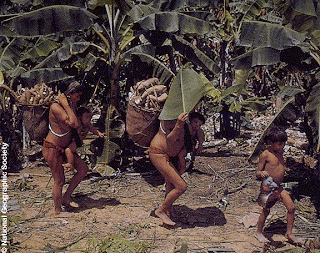Why do women
enjoy shopping more than men do? We know
men love to buy things, and spend money, but why is shopping considered
something women enjoy doing more than men? I have a theory as to why this is.
 |
| Modern example of hunting by !Kung San from southern Africa |
For hundreds of thousands of years
we have been hunters and gathers and between men and women there existed a
specific division of labour. This
division of labour was not based on some sexist notion but out of a practical
one, based on the differences between men and women. Men did the majority of hunting while women
did the majority of gathering. Small
groups of men would spend hours and even days out on hunting parties, and
women, along with their children, would spend their day gathering all of the
edible plants, roots, tubers and other fruits around the base camp. Women also regularly hunted and captured
small game, so they were not excluded from the savage act that only men were
expected to perform.
The scenario during a hunt centered around a small group of men working together and quietly stalking an animal. The men would have developed many signs and “looks” to communicate covertly in order not to startle their prey. On their hunting trip men would bring small portions food to sustain them, or gather whatever foods they could find. But on the whole they ate only when they were not stalking their prey.
 |
| Modern example of Yanomami women gathering food from the Amazon region in South America |
The situation with the women on the
other hand was much different while gathering food, which was the main source
of food for the average small and mobile communities. Small groups of women with their children would go out from the camp and
gather the various foods. This was a
more communal atmosphere where the women would be free to talk amongst
themselves, without the fear of startling their prey. Over the course of the gathering they would
taste and sample the produce as they moved in order to rate its quality and
ripeness. Not all foods could be sampled
and some foods needed preparation though peeling, crushing or cooking to become
edible. Young children at various ages
would accompany and participate in the collecting and be learning what was
ready to pick and what was not.
This behaviour is mirrored in the activities of men and women today in the 21st century. Women by their nature snack while cooking and taste (sample) foods at the grocery story, usually accompanied by their children. The usual scene of women together when cooking is constant chatting. The men on the other hand don’t exactly act as their hunting ancestors did, but there are times when men are together and say very little to each other, but can still have a deep acknowledgement from just a “look”.
This behaviour is mirrored in the activities of men and women today in the 21st century. Women by their nature snack while cooking and taste (sample) foods at the grocery story, usually accompanied by their children. The usual scene of women together when cooking is constant chatting. The men on the other hand don’t exactly act as their hunting ancestors did, but there are times when men are together and say very little to each other, but can still have a deep acknowledgement from just a “look”.
 |
| Gathering in the modern age |
What does this mean for Marketing
Research?
The shopping experience
 |
| The mother/child dynamic with gathering has not changed in thousands of years |
 |
| The solitary hunter |
People are also very vocal and if they
recommend a product to family and friends the first question they are asked is
“where can I find it?” This goes beyond
just identifying a specific store, just like during our hunter-gatherer days,
people want to know exactly over which hill and behind which bush to find those
great ripe berries. People will
rarely search all over a store for something if it's not where they expect to find it.
 |
| Cavemen went extinct long before the supermarket arrived |
In conclusion, are modern supermarkets maximizing the shopping experience? Or is there something more they can do?
Here is my suggestion. One important aspect of the shopping experience that is different from when our ancestors gathered for food is the lack of information. Groups of women would go gathering together and share information on all the different foods available. With the vast array of edible products in supermarkets, one idea is to employ roving "Product Specialists" throughout the store. These people can suggest recipes or answer questions regarding different foods to make recommendations. Suggestions such as different spices, side dishes and condiment pairings and get people to go to different parts of the store they would not normally go to. Since people visit their local supermarkets regularly these Product Specialists can also act as the front line interaction with the customer and build relationships over the long term.
 |
| The missing piece of the gathering paradigm? |
Due to the fact that everyone needs to eat, our supermarkets should not merely a be a commercial experience but should be places where people can explore culinary delights from around the world. If they enjoy their shopping experience, this is one way to encourage people to return and tell their friends and family, which for thousands of years has always been the best form of advertising.

No comments:
Post a Comment